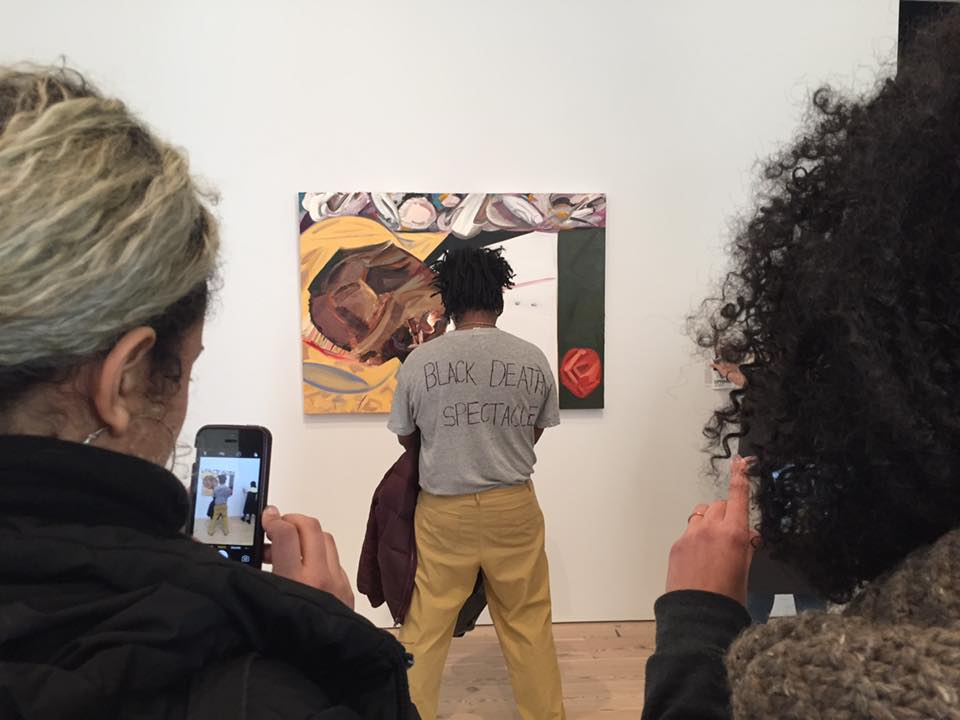In Dana Schutz’s Open Casket, Interrogating the Aesthetics of Erasure
In the wake of numerous killings of black men and women by police, representation of black death in media and art has become a heated debate. The most recent turn in this discussion does not surround a recent killing, but a murder over six decades old. At the 2017 Whitney Biennial, a prominent art show in New York, artist Dana Schutz has faced sustained protest from artists and activists over Open Casket, a painting depicting the body of Emmett Till, a black teenager brutally murdered by two white men in 1955.
Critics have called the painting insensitive and exploitative, criticisms levied on the fact that Schutz is a white artist depicting a black teenager’s death. The controversy has risen to national prominence in the wake of an open letter written by artist Hannah Black and signed by over 20 of her peers. In the letter, Black blasts Schutz for appropriating themes of black suffering in her artwork, arguing that she uses “Black pain as raw material.” Black ultimately calls for the work to be removed from the Biennial and destroyed.
There are several arguments central to the debate around Schutz’s painting, encompassing both content and context. Perhaps most prominent is the discussion around Black’s call for removal and destruction of the artwork, and whether such actions merit censorship. There are also questions of whether Schutz is exploiting the suffering of black people as a tool to promote and lend meaning to her own artwork. These questions should not be brushed aside, and will likely define the legacy of Open Casket and the 2017 Whitney Biennial for years to come.

Schutz, Dana. Open Casket, 2016. Oil on canvas. 39 × 53 in. (99 × 134.6 cm). Collection of the artist (courtesy of the Whitney Museum of American Art).
Also under fire are the aesthetic properties of Open Casket. In particular, critics have argued that Schutz’s relatively abstract approach in painting Till, most notably his face, is at fault; doing so, they argue, erases the true horror of Till’s death, rendering it in an aesthetic manner that obscures its original political significance. Mamie Till Mobley, Emmett’s mother, decided to hold an open casket funeral so she could show the world what Till’s white killers had done. The reason the resulting images are so powerful is precisely because of the detailed, unflinching depiction of Till’s mutilation. Schutz’s work fails to represent that fact; indeed, it takes an opposite approach.
When considering this argument, though, one question must be asked: do artistic representations of Till’s death today bear the same burden of representing his death as in 1955? In the case of simply informing the viewer, it would seem that evidence points to no. Foremost in this argument is the fact that Till’s image is no longer new to the public. On the contrary, the image of Till’s open casket is well known; the image became a founding cornerstone of the Civil Rights movement, and remains a central point in America’s ongoing struggles over race. At this point, then, artistic representations of Till may not be required to meet the same standards of informing the viewer in a solely naturalistic manner than if they were made at an earlier point.
In fact, pieces that reference Till’s murder and recast it in a new light can add to, rather than detract from, understanding of the event’s profound injustice. Take, for example, Carrie Iverson’s 2002 work, Till, which eschews any depiction of Till himself but instead focuses on the role of landscape of the murder (specifically, the river into which the killers threw Till’s body after tying him to a cotton gin fan). Like Schutz’s work, Iverson’s etching does little to suggest the established imagery of Till’s death. Instead, by using a relatively abstract approach, works like Iverson’s and Schutz’s force the viewer to reflect on the connection between the artwork and the event that it represents – a far cry from obscuring its horror.
By opting for abstraction, Schutz’s work may even encourage reflection on the horrific acts it references without courting problematic forms of morbid curiosity. A key example in this regard is Ti-Rock Moore’s 2015 exhibition, “Confronting Truths: Wake Up!” Made in response to the killing of Michael Brown in Ferguson, Missouri, Moore’s exhibition featured a replica of Brown’s body lying face-down in the center of the gallery. Though one side of Brown’s family supported the artwork, Michael Brown Sr. called the artwork “disturbing” and “disgusting” for portraying his son’s killing in such a way.
Works like Moore’s are especially controversial because of the shock value emphasized as a fundamental principle of the work. Shocking the viewer can be effective in conveying a message of social change, as the original photographs of Till’s body show. However, artwork operating on shock value also runs the risk of exploiting morbid curiosity to achieve its aim. By opting for a less naturalistic approach, Schutz’s work creates a mediating layer between the viewer and the original experience, lessening the visceral effects of morbid curiosity that could plague an approach showing Till’s injuries in greater detail.
If Schutz’s stylistic choices can be justified as a legitimate response to Emmett Till’s murder, the question then shifts to whether such choices betray the original intent of Till’s open casket. Convinced that “everybody needed to know what had happened to Emmett Till,” Mamie Till Mobley decided that her son’s casket would be open at his funeral. The resulting images are shocking for the violence that they depict, a characteristic largely absent from Schutz’s abstract treatment of the scene. This has led some to criticize her for appropriating the imagery of the open casket for her own ends, rather than preserving the political message Till’s open casket was meant to convey. In this regard, Schutz’s work may fall short; without conveying the plain horror of the incident, her work does not capture the killing of Emmett Till in a holistic way.
However, this abstraction should not be seen as inherently meaningless. Surely, the detail to which Till’s mutilation is shown in the original images provokes horror. Yet horror also stems from the fact that his face is so brutally disfigured by this violence. The images of Till are searing not just because he was violently murdered and disfigured, but that these injuries obscured his humanity to the point where he could only be identified by an initialed ring on his finger. The family photos of Till placed around the casket lining at his funeral reinforce this point – white supremacy dehumanizes through its violence, reducing a 14-year-old boy to a swollen, unrecognizable body in a casket.
Contrary to obscuring the horror of Till’s mutilation, then, Schutz’s work can be interpreted as referencing the dehumanizing injustice central to his death. The abstraction she employs forces the viewer to focus on the injustice of what is missing, rather than what is present. This is even more relevant considering Schutz’s stated approach – that she chose to portray Till as a mother empathizing with Mamie Till Mobley. As the title of the work suggests, this is the last time Till’s mother will look upon her son’s face. There is a profound injustice to be found in this fact – that Mamie’s last view of her son was one marred and obscured by the violence of white supremacy. Representing this tragedy should serve as a reason to appreciate the work, not as a point meriting its destruction.
Certainly, questions will remain of whether Schutz was justified in making Open Casket in the first place. One finds few easy answers in coming to terms with this question. What may be easier, then, is a recognition that Schutz’s painting has artistic merit, regardless of the questions surrounding its authorship. On one hand, it is difficult to argue that Schutz’s work can be seen as a holistic documentation of Emmett Till’s murder, especially given its level of abstraction. Yet it is equally difficult to argue that this abstraction does not meaningfully draw attention to the forces of dehumanization that made Till’s death so tragic in the first place. It is under this framework that Open Casket should be considered – as a work that exposes the violence of white supremacy’s erasure.





